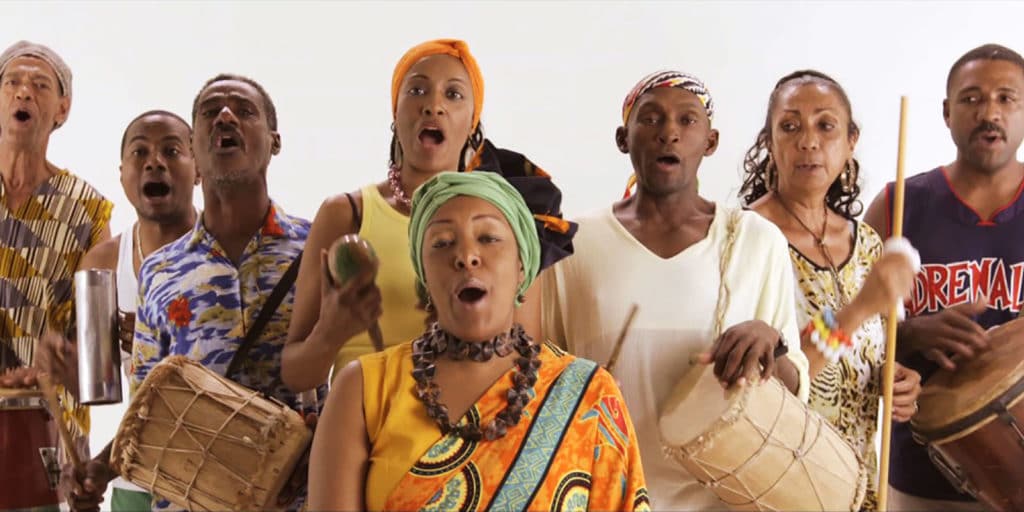Betsayda Machado y Parranda El Clavo is a Venezuelan tambor group.
Flushing Town Hall
Saturday, February 29, 2020 ~ Betsayda Machado y Parranda El Clavo join Michael Winograd and the Honorable Menshn for a Jewish-klezmer-African-Venezuelan tambor performance and jam session at the Flushing Town Hall in Flushing, Queens. Dance lesson at 7:15pm. Concert at 8pm.
Teens free, $12 students, then $18. Tickets at flushingtownhall.org
Betsayda Machado y Parranda El Clavo
Betsayda is from El Clavo, Barlovento, Miranda, Venezuela. Billed as “The Voice of Venezuela,” she sings Venezuelan folk music with her life-long friends Parranda El Clavo. They describe their work as “a spirit-shaking percussion and voice fiesta, said to make dancers float.”
If you ever sat next to an African drum being played, you know that it will shake your spirit. The African drum is a healing instrument and drum sessions begin with an ancestral call.
Religious experience or just having fun both intend to lift your spirits. Syncopation, which is accented rhythms off of the main down beat, intends to lift the music and the dancers. You see this in jazz, reggae, salsa and reggaeton where syncopated rhythms offer endless opportunities for improvisational variation. Syncopation gets you out of yourself.
Watch a Latin dance floor. There is a moment a little after the music starts when the dancers click together with the rhythm and the energy in the room starts to float. This is what Betsayda Machado y Parranda El Clavo do Venezuelan style.
In 2020, Betsayda Machado y Parranda El Clavo celebrates 30 years together.
betsayda.com
Instagram @parrandaelclavo
Barlovento, Venezuela
“Barlovento” means windward or facing the wind. The winds brings heavy rains to the Venezuelan interior or across the ocean to the Canary Islands off of Africa. These winds even bring sand from the Sahara all the way to Puerto Rico and the Lesser Antilles.
Chocolate is made from cacao which is native to the upper Amazon in Venezuela and Colombia. In the colonial time of human enslavement, the Barlovento region was a cacao growing region.
Africans in the region originated in Central Africa around the Congo River basin in what is now the Republic of the Congo, Democratic Republic of the Congo and Angola.
Tambor
In Venezuela, African and colonial-Spanish traditions mixed into Tambor, or “drum dancing,” the Afro-Venezuelan dance music. Venezuelan tambor, Colombian cumbia, Cuban rumba, and Puerto Rican bomba are all unique, but similar traditions.
Drumming, singing and dancing are expressions of both belonging to a group and one’s individuality within the group. The traditions survive in family groups. If our families have been “separated” which was a common slaver’s strategy, we create our own families.
One of the ways we bond is by drumming, singing and dancing together. This remains true in the Caribbean today and even in New York City. Watch a family group or a bunch of young people dance reggaeton together and you will see basically the same thing happening. This is African culture. Even that strut down the middle between two lines of people is African. We even saw it on the Soul Train dance television show in the 1970s.
These are human song and dance rituals that can be religious, healing or courting. It’s what people do when the work is done and you want to share the joys and sorrows of life with someone.
When you think about it, English country dancing, Spanish flamenco and all forms of folk dancing around the world are the same type of human expression. I wonder why we think these are any different.
In the past Tambor drum dancing would have been done whenever there was a day off which in colonial times was usually on Sundays. Carnival was a special time because it was the only time Africans were allowed to celebrate their own culture.
Today the traditions mostly survive as folk traditions on special occasions. In Venezuela Tambor is popular on the Feast of San Juan, the Burial of the Sardine (Entierro de la Sardina) and the Day of the Dead.
The Feast of San Juan is a Catholic tradition that mixed with popular midsummer celebrations. The Burial of the Sardine is the traditional end of Carnival. Carnival is a reversal festival with shall we say, “more relaxed” traditions. The burial basically means that whatever happened in Carnival, stays in Carnival.
The Day of the Dead is perhaps best known in the United States through its Mexican form which blended Spanish and Aztec commemorations of deceased family members. But the tradition was celebrated throughout the Hispanic world. West African and Central African drum sessions begin with a call to the ancestors. It’s a perfect match with the Day of the Dead.
We are taught to see our differences, when in fact our similarities are what is most striking.
Betsayda Machado y Parranda El Clavo represent a rich manifestation of the African traditions of Venezuela.

